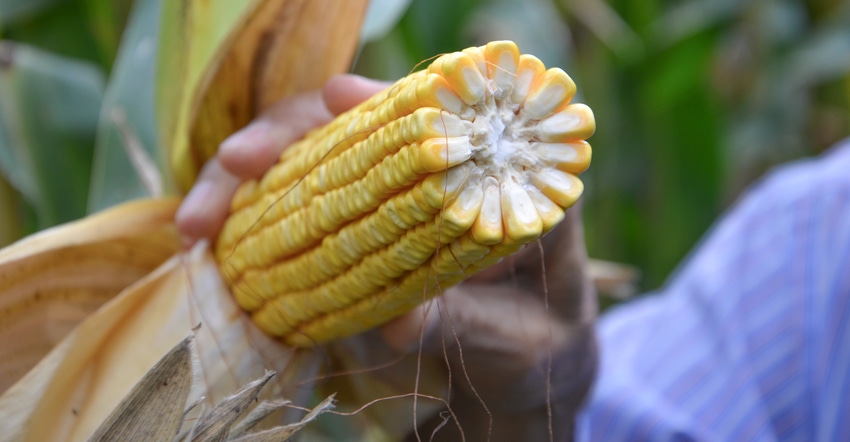
The two hybrids planted side by side across the Corn Watch ’18 field have many differences. One is taller; one has tassels with more branches. Ear height is closer to the ground and more consistent for one hybrid than the other. The shorter-stature hybrid has a fixed ear with 16 to 18 rows of kernels per ear. The taller hybrid has a flex ear with 14 to 16 rows of kernels, but more kernels per row. Kernels are longer and set deeper into the cob on the flex-ear hybrid.
These are some of the visible ways you can distinguish between the two hybrids in the field, says Dave Nanda, a former plant breeder who is now an independent crop consultant based in Indianapolis. Nanda has observed the Corn Watch ’18 field during the season. Corn Watch ’18 is sponsored by Seed Genetics-Direct, Washington Court House, Ohio.
“There’s one more difference which isn’t evident until you pull an ear from each hybrid and break them in two,” Nanda says. “One has a red cob, and one has a white cob.”
Red cobs are more common in the industry, but there are no negatives attached to white cobs, he says. It’s just another characteristic controlled by plant genetics. If a white cob hybrid is a great yielder and has other quality traits, it’s as good as any other hybrid, he says.
What makes cob white
The white cob is purely a matter of genetics, Nanda says. The plant breeder who made the final cross to produce the hybrid selected two inbred parents that both carried the white cob trait.
If you know about Gregor Mendel, the Austrian monk, and his pea experiments, it may take Nanda’s plant breeding expertise to get your head around why both inbred lines must have white cobs. Mendel discovered that in simple crosses, there are dominant and recessive traits. For example, if dark-green pea pods were dominant and light-green were recessive, the cross between two dark-green-podded pea plants could still produce 25% light-green-podded plants if both carried the recessive trait for light-green pod color.
It doesn’t work that way when you’re crossing inbred corn lines, Nanda explains. “It’s because the inbred lines are homozygous, or genetically uniform,” he says. “The plant breeder continued inbreeding until he had an inbred line which always produced plants like itself.
“To get a white cob, both inbred parents must have white cobs. If one had a red cob and the red cob trait is dominant, then you would get red cobs.”
For each plant of a hybrid to be uniform, the inbred parents must be homozygous, Nanda continues. If you find a plant with widely different characteristics within a hybrid, it’s either an inbred plant, or it may be a different hybrid if you planted refuge-in-a-bag corn for refuge protection of GMO insect traits.
About the Author(s)
You May Also Like




